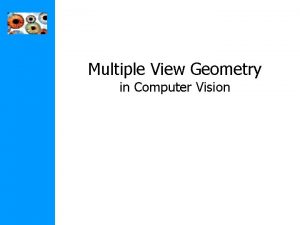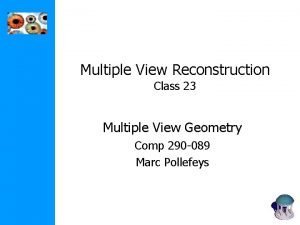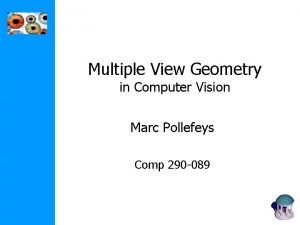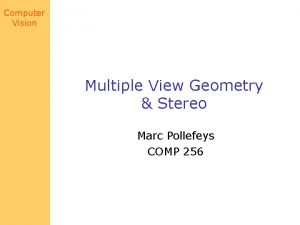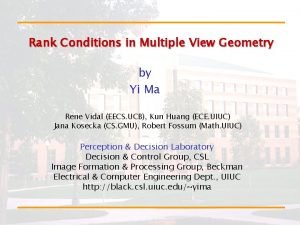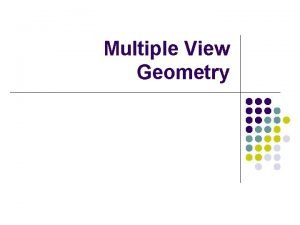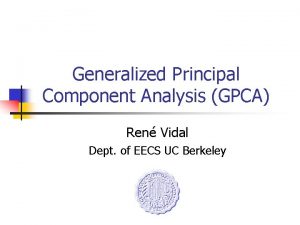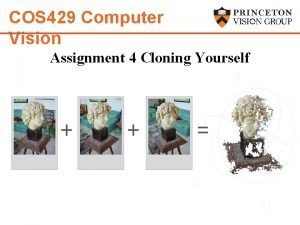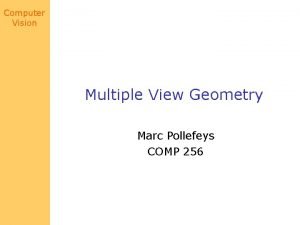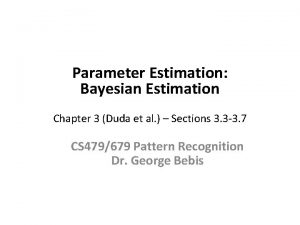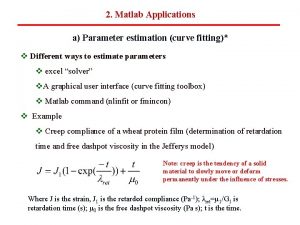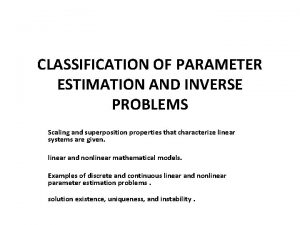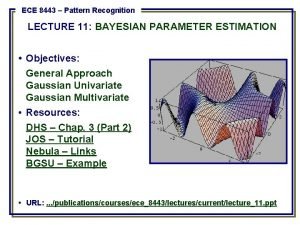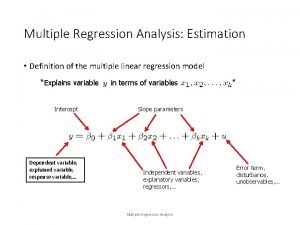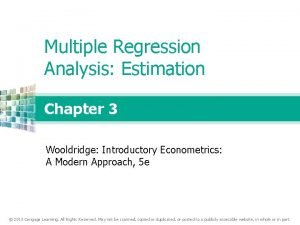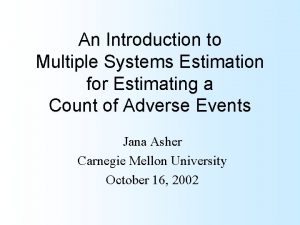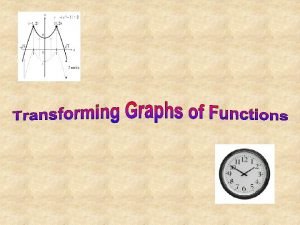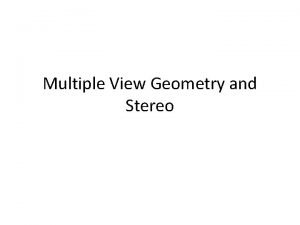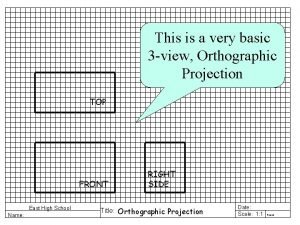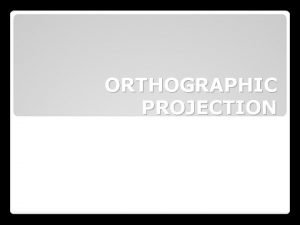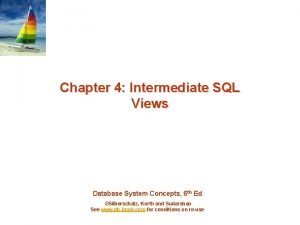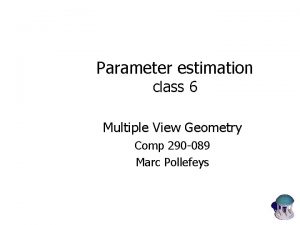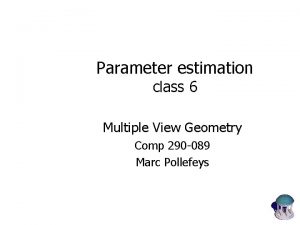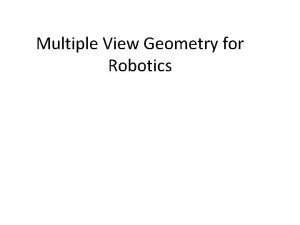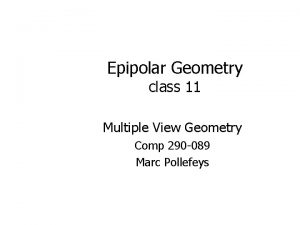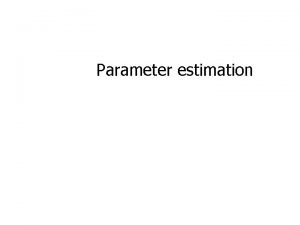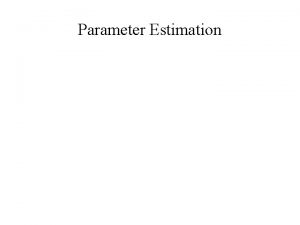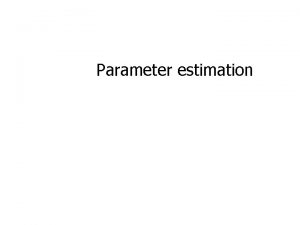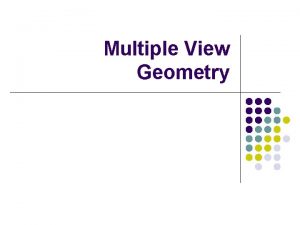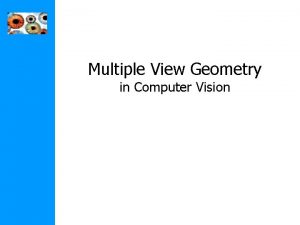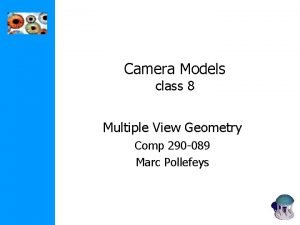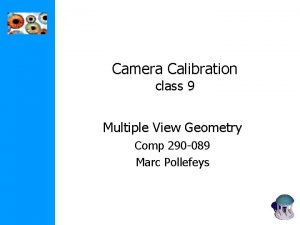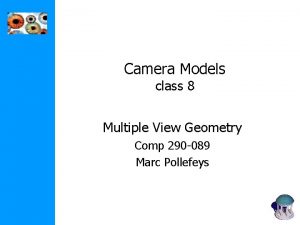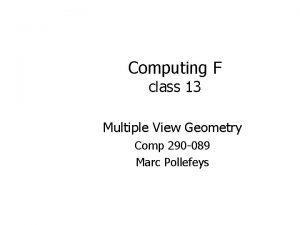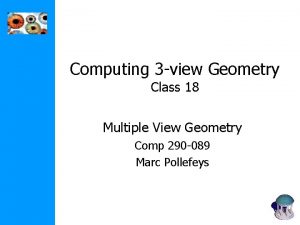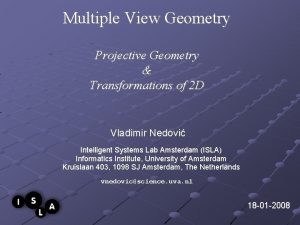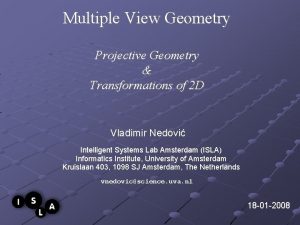Parameter estimation class 5 Multiple View Geometry Comp
































- Slides: 32

Parameter estimation class 5 Multiple View Geometry Comp 290 -089 Marc Pollefeys

Content • Background: Projective geometry (2 D, 3 D), Parameter estimation, Algorithm evaluation. • Single View: Camera model, Calibration, Single View Geometry. • Two Views: Epipolar Geometry, 3 D reconstruction, Computing F, Computing structure, Plane and homographies. • Three Views: Trifocal Tensor, Computing T. • More Views: N-Linearities, Multiple view reconstruction, Bundle adjustment, autocalibration, Dynamic Sf. M, Cheirality, Duality

Multiple View Geometry course schedule (subject to change) Jan. 7, 9 Intro & motivation Projective 2 D Geometry Jan. 14, 16 (no class) Projective 2 D Geometry Jan. 21, 23 Projective 3 D Geometry (no class) Jan. 28, 30 Parameter Estimation Feb. 4, 6 Algorithm Evaluation Camera Models Feb. 11, 13 Camera Calibration Single View Geometry Feb. 18, 20 Epipolar Geometry 3 D reconstruction Feb. 25, 27 Fund. Matrix Comp. Structure Comp. Planes & Homographies Trifocal Tensor Three View Reconstruction Multiple View Geometry Mar. 4, 6 Mar. 18, 20 Mar. 25, 27 Multiple. View Reconstruction Bundle adjustment Apr. 1, 3 Auto-Calibration Papers Apr. 8, 10 Dynamic Sf. M Papers Apr. 15, 17 Cheirality Papers Apr. 22, 24 Duality Project Demos

Projective 3 D Geometry • Points, lines, planes and quadrics • Transformations • П∞, ω∞ and Ω ∞

Singular Value Decomposition Homogeneous least-squares

Parameter estimation • 2 D homography Given a set of (xi, xi’), compute H (xi’=Hxi) • 3 D to 2 D camera projection Given a set of (Xi, xi), compute P (xi=PXi) • Fundamental matrix Given a set of (xi, xi’), compute F (xi’TFxi=0) • Trifocal tensor Given a set of (xi, xi’, xi”), compute T

Number of measurements required • At least as many independent equations as degrees of freedom required • Example: 2 independent equations / point 8 degrees of freedom 4 x 2≥ 8

Approximate solutions • Minimal solution 4 points yield an exact solution for H • More points • No exact solution, because measurements are inexact (“noise”) • Search for “best” according to some cost function • Algebraic or geometric/statistical cost

Gold Standard algorithm • Cost function that is optimal for some assumptions • Computational algorithm that minimizes it is called “Gold Standard” algorithm • Other algorithms can then be compared to it

Direct Linear Transformation (DLT)

• Direct Linear Transformation (DLT) Equations are linear in h • Only 2 out of 3 are linearly independent (indeed, 2 eq/pt) (only drop third row if wi’≠ 0) • Holds for any homogeneous representation, e. g. (xi’, yi’, 1)

Direct Linear Transformation (DLT) • Solving for H size A is 8 x 9 or 12 x 9, but rank 8 Trivial solution is h=09 T is not interesting 1 -D null-space yields solution of interest pick for example the one with

Direct Linear Transformation (DLT) • Over-determined solution No exact solution because of inexact measurement i. e. “noise” Find approximate solution - Additional constraint needed to avoid 0, e. g. not possible, so minimize

DLT algorithm Objective Given n≥ 4 2 D to 2 D point correspondences {xi↔xi’}, determine the 2 D homography matrix H such that xi’=Hxi Algorithm (i) For each correspondence xi ↔xi’ compute Ai. Usually only two first rows needed. (ii) Assemble n 2 x 9 matrices Ai into a single 2 nx 9 matrix A (iii) Obtain SVD of A. Solution for h is last column of V (iv) Determine H from h

Inhomogeneous solution Since h can only be computed up to scale, pick hj=1, e. g. h 9=1, and solve for 8 -vector Solve using Gaussian elimination (4 points) or using linear least-squares (more than 4 points) However, if h 9=0 this approach fails also poor results if h 9 close to zero Therefore, not recommended Note h 9=H 33=0 if origin is mapped to infinity

Degenerate configurations x 1 x 4 x 2 x 3 Constraints: H? (case A) x 1 x 4 x 2 x 3 H’? (case B) x 1 x 2 x 4 x 3 i=1, 2, 3, 4 Define: Then, H* is rank-1 matrix and thus not a homography If H* is unique solution, then no homography mapping xi→xi’(case B) If further solution H exist, then also αH*+βH (case A) (2 -D null-space in stead of 1 -D null-space)

Solutions from lines, etc. 2 D homographies from 2 D lines Minimum of 4 lines 3 D Homographies (15 dof) Minimum of 5 points or 5 planes 2 D affinities (6 dof) Minimum of 3 points or lines Conic provides 5 constraints Mixed configurations?

Cost functions • Algebraic distance • Geometric distance • Reprojection error • Comparison • Geometric interpretation • Sampson error

Algebraic distance DLT minimizes residual vector partial vector for each (xi↔xi’) algebraic error vector algebraic distance where Not geometrically/statistically meaningfull, but given good normalization it works fine and is very fast (use for initialization)

Geometric distance measured coordinates estimated coordinates true coordinates d(. , . ) Euclidean distance (in image) Error in one image e. g. calibration pattern Symmetric transfer error Reprojection error

Reprojection error

Comparison of geometric and algebraic distances Error in one image typical, but not , except for affinities For affinities DLT can minimize geometric distance Possibility for iterative algorithm

Geometric interpretation of reprojection error Estimating homography~fit surface to points X=(x, y, x’, y’)T in 4 represents 2 quadrics in 4 (quadratic in X) Analog to conic fitting

Sampson error between algebraic and geometric error Vector that minimizes the geometric error is the closest point on the variety to the measurement Sampson error: 1 st order approximation of Find the vector that minimizes subject to

Find the vector that minimizes Use Lagrange multipliers: minimize derivatives subject to

Sampson error between algebraic and geometric error Vector that minimizes the geometric error is the closest point on the variety to the measurement Sampson error: 1 st order approximation of Find the vector that minimizes subject to (Sampson error)

Sampson approximation A few points X=(x, y, x’, y’) (ii) (iii) For a 2 D homography (iv) Similar to algebraic error in fact, same as Mahalanobis distance Sampson error independent of linear reparametrization (cancels out in between e and J) (v) is the algebraic error vector is a 2 x 4 matrix, e. g. (vi) Must be summed for all points (vii) Close to geometric error, but much fewer unknowns

Statistical cost function and Maximum Likelihood Estimation • Optimal cost function related to noise model • Assume zero-mean isotropic Gaussian noise (assume outliers removed) Error in one image Maximum Likelihood Estimate

Statistical cost function and Maximum Likelihood Estimation • Optimal cost function related to noise model • Assume zero-mean isotropic Gaussian noise (assume outliers removed) Error in both images Maximum Likelihood Estimate

Mahalanobis distance • General Gaussian case Measurement X with covariance matrix Σ Error in two images (independent) Varying covariances

Next class: Parameter estimation (continued) Transformation invariance and normalization Iterative minimization Robust estimation

Upcoming assignment • Take two or more photographs taken from a single viewpoint • Compute panorama • Use different measures DLT, MLE • Use Matlab • Due Feb. 13
 Multiple view geometry in computer vision.
Multiple view geometry in computer vision. Multiple view geometry
Multiple view geometry Multiple view geometry in computer vision
Multiple view geometry in computer vision Multiple view geometry in computer vision solution manual
Multiple view geometry in computer vision solution manual Multiple view geometry
Multiple view geometry Quadrifocal
Quadrifocal Multiple view geometry
Multiple view geometry Multiple view geometry
Multiple view geometry Multiple view geometry
Multiple view geometry Bayesian estimation
Bayesian estimation Matlab parameter estimation
Matlab parameter estimation Parameter estimation and inverse problems
Parameter estimation and inverse problems Bayesian parameter estimation in pattern recognition
Bayesian parameter estimation in pattern recognition Multiple regression definition
Multiple regression definition Direction of omitted variable bias
Direction of omitted variable bias Multiple systems estimation
Multiple systems estimation Lewis dot structure and molecular geometry
Lewis dot structure and molecular geometry 4 electron domains 2 lone pairs
4 electron domains 2 lone pairs Molecular geometry and bonding theories
Molecular geometry and bonding theories Multiple transformations geometry
Multiple transformations geometry Multiple probe vs multiple baseline
Multiple probe vs multiple baseline Multiple instruction multiple data
Multiple instruction multiple data Single view geometry
Single view geometry Single view geometry
Single view geometry Orthographic
Orthographic Revolved view
Revolved view Section views
Section views Section line symbol
Section line symbol Birds eye and worm's eye
Birds eye and worm's eye Orthographic projection
Orthographic projection Orthographic projection of isometric drawing
Orthographic projection of isometric drawing For the view create view instructor_info as
For the view create view instructor_info as Simple view and complex view
Simple view and complex view
